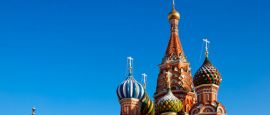Named after Maxim Gorky, this huge public park was made world-famous by the Martin Cruz Smith novel and film of the same name, but far from being a gloomy Cold War relic, it is an inviting green space where Muscovites unwind. With sprawling pathways, ornamental flowerbeds and shady arcades of trees, it’s a popular spot for a riverside stroll and you can pause to admire the Buran, a Russian space shuttle that never left the ground.
Things to see in Moscow
Tourist offices
Address: 15/5 5th Donskoy proyezd, Moscow, 119334, Russia
Tel: +7 495 730 1937
Opening Hours:
Mon-Fri 0900-1730.
www.intourist.comUntil recently, the Intourist travel company doubled as the official state tourist board, but today it is just one of many tour agencies that can help with visa applications and package tours. In the absence of an official tourist office, the InTourist desk at Hotel Cosmos can provide basic tourist information. Other useful sources of information include foreign embassies in Moscow and the information desk at the Metropol Hotel, Teatralny proezd 2 (tel: +7 499 501 7800).
The Moscow Pass, available overseas from offices of the Russia National Tourist Office (www.visitrussia.org.uk), offers free entry to many of the most popular museums and attractions. The pass is available for one, two or three days.
Nerve centre of the Russian state, the Kremlin (literally ‘fortified town') is Russia’s single most famous monument. With its iconic skyline of 15th- and 16th-century churches and palaces, this walled fortress was actually founded in 1147. Its golden era was from 1276 to 1712, as the seat of the grand princes and tsars of Russia, though its place in popular culture was assured by its role as the headquarters of the government of the Soviet Union. As a result of Cold War fiction, its reputation exceeds its true historical role, but there's no better place to consider the fascinating complexities of Russia’s story.
Nothing says 'Moscow' like the candy-coloured domes of St Basil's Cathedral. Rising surreally from Red Square, and crowned by a sweetshop collection of spires and onion domes, this amazing piece of architectural confectionary is one of the planet’s most striking buildings. Built in the 1550s to commemorate Ivan the Terrible's victory over the Mongols, today it houses Moscow’s finest collection of religious icons and murals.
The star-topped walls of the Kremlin and the coloured domes of St Basil’s Cathedral dominate Red Square, the centrepiece of historic Moscow. Once the setting for shows of military prowess during the Cold War, the troops still gather here annually for Moscow’s famous Victory Day parade. Landmark monuments dot its edge, including Lenin’s Mausoleum, the State Historical Museum and the GUM Department Store.
This handsome cathedral is a monument to the struggles of 20th-century Moscow. Originally constructed between 1883 and 1889 to commemorate victory over Napoleon, Stalin had the church demolished in 1930 to make way for a vain skyscraper. It was later turned into a huge outdoor swimming pool. The cathedral’s gleaming resurrection was completed in 1997.
The founder of the Soviet Union is preserved for posterity on the eastern side of the Kremlin in a red and black granite mausoleum facing Red Square. Lenin died in 1924 and his embalmed body was installed inside the mausoleum in a crystal casket, becoming a point of pilgrimage for devoted Russian citizens. Visitors should be respectful (no hats, cameras or hands in pockets) when visiting. Note: the mausoleum often closes without notice.
Founded in 1524 by Grand Prince Vassily III, Novodevichy Convent is dominated by the Cathedral of the Virgin of Smolensk, a classic piece of Russian Orthodox architecture crowned by golden domes and a tiered bell tower. The convent was a place of exile for noblewomen in mourning or disfavour, and it remains one of the most intact medieval monastic complexes in Russia. Inside are 16th-century frescoes and a magnificent late 17th-century iconostasis. The adjacent cemetery contains the graves of many distinguished Muscovites, including Anton Chekhov.
More than a musty collection of historical artefacts, every room here is decorated in the style of a different historical period or region. Permanent exhibitions display treasures from all over Russia, including a 5,000-year-old longboat unearthed beside the River Volga and racks of medieval armour and weapons. Exhibits from Siberia, Altay and Kievan Rus reflect the broad cultural and ethnic diversity of the country. Descriptions are in Russian, but English tours are available.
Bringing together the most important Russian icons in the world, this gallery covers Russian Orthodox art from early Byzantine times to the 17th century. Its most famous piece is an exquisite portrait of Madonna and child known as The Vladimir Virgin. There are also works by Theophanes the Greek, Dionysius and Andrey Rublyov. The collection includes recent Russian art up to the early 20th century.
This fascinating museum sits in the shadow of the 100m-high (328ft) titanium Space Obelisk, covered in frescoes depicting triumphs of Soviet space exploration. Spread over nine pavilions, it celebrates Russian achievements in science, space and engineering. Outside are two Tupolev passenger aircrafts and a Vostok rocket, the type that took Yuri Gagarin into space.
Do you have any Feedback about this page?
© 2025 Columbus Travel Media Ltd. All rights reserved. No part of this site may be reproduced without our written permission, click here for information on Columbus Content Solutions.








 You know where
You know where